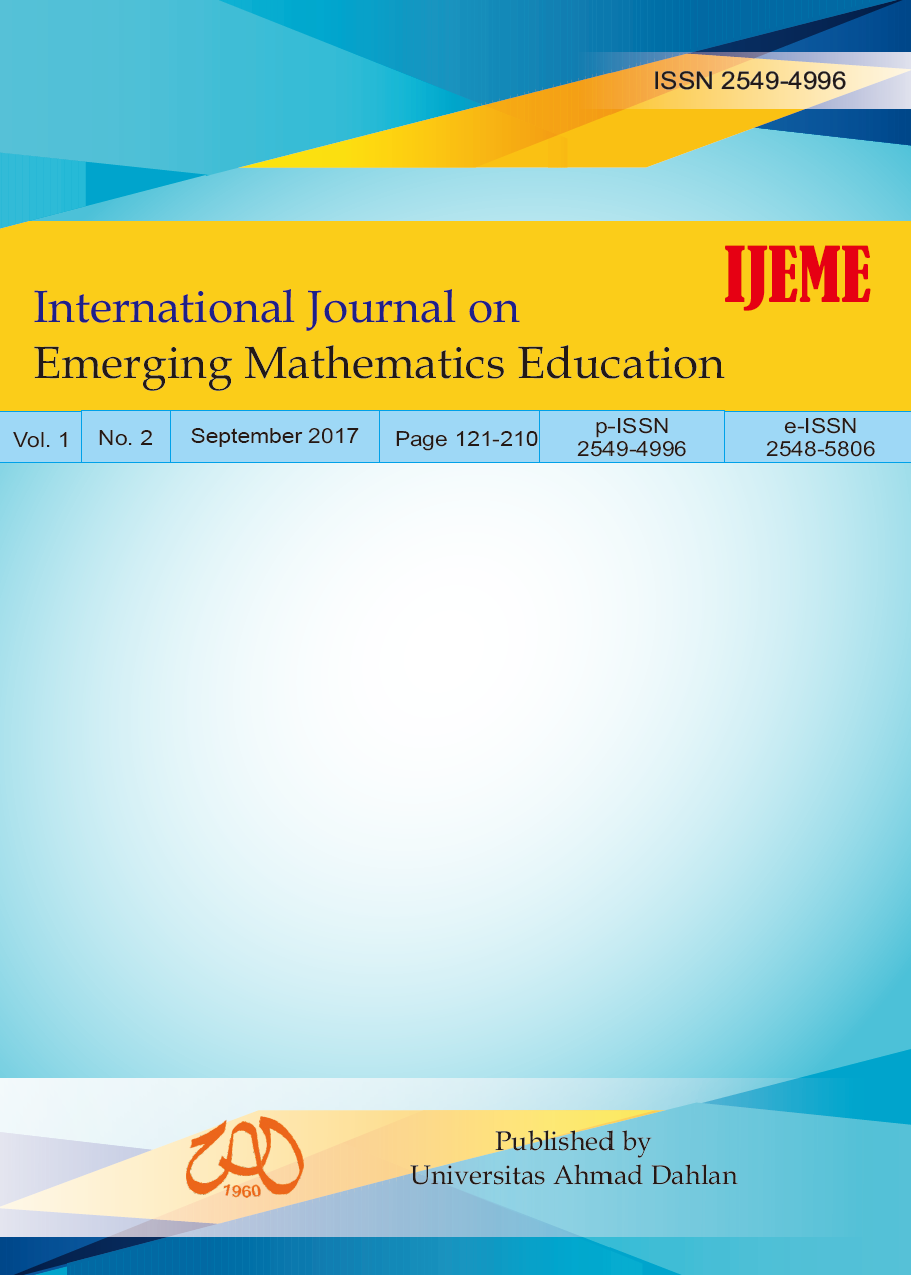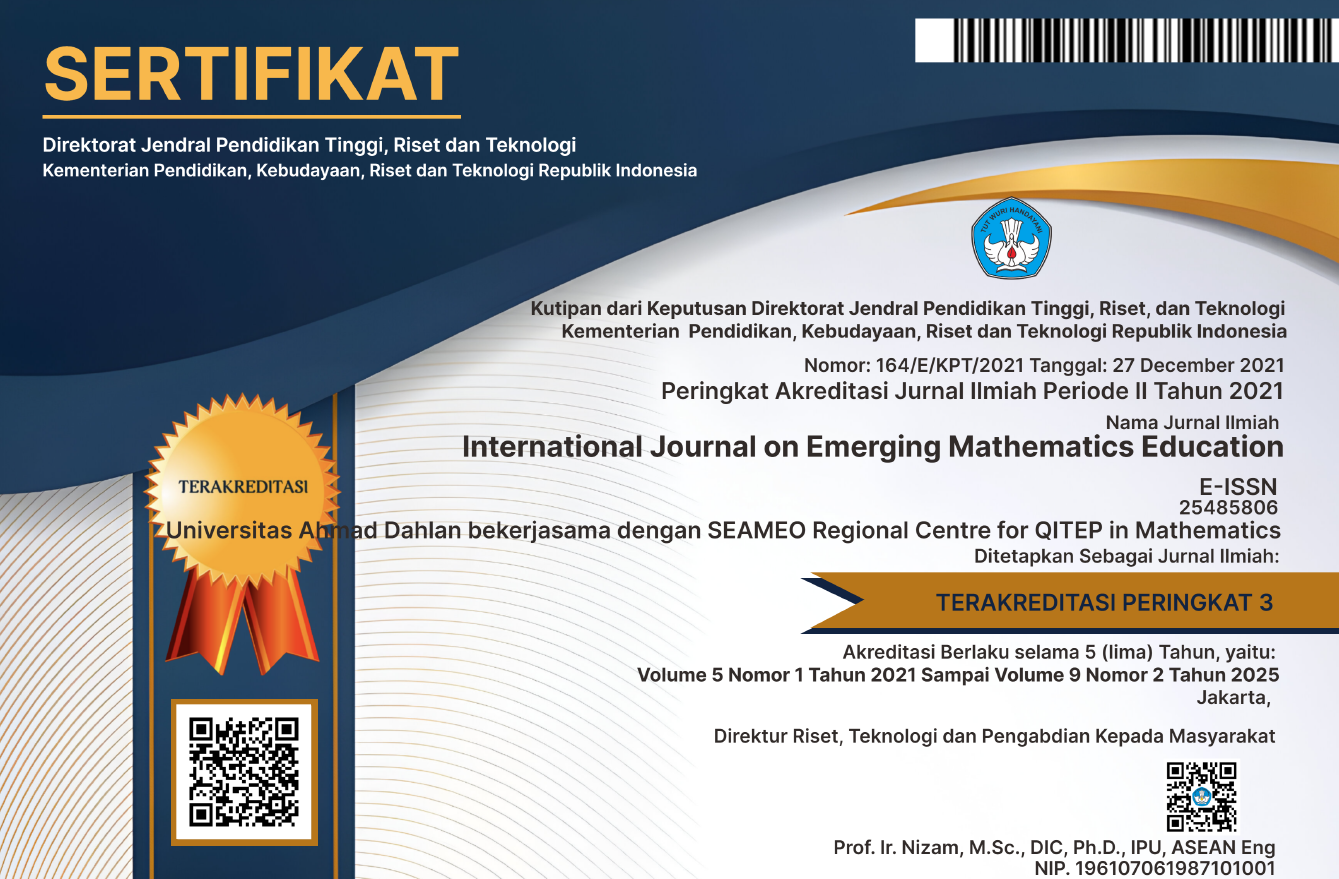Learning 2-Dimensional and 3-Dimensional Geometry with Geogebra: Which Would Students Do Better?
DOI:
https://doi.org/10.12928/ijeme.v1i2.5541Keywords:
Geometrical thinking, GeoGebra, Van HieleAbstract
The purpose of this study is to examine the geometric thinking of young children who worked with GeoGebra to learn two-dimensional (2-D) and three-dimensional (3-D) geometry. GeoGebra is an open sourced dynamic mathematics software which is applicable for learning mathematics from primary school to secondary school and to higher education. Thirty pupils studying in second grade (Year 2) at a school located in Pontian, a district in one of the Malaysian state participated in the study. They attended GeoGebra sessions to construct and analyze dynamics of two-dimensional and three-dimensional geometry after learning these topics in the conventional setting. Pretest and posttest on two-dimensional and three-dimensional spatial ability based on Van Hiele level of geometric thinking were administered to the pupils. The comparison between pretest and posttest results demonstrate significant enhancement in visualization and informal deduction for both 2-D and 3-D geometry. Moreover from the intervention, the students benefit most in analyzing 3-D and visualizing 2-D geometry. Interestingly, skills and knowledge acquired through activities using GeoGebra in student-centered learning environment could be successfully transferred to paper and pencil test.
References
Abdullah, A.H., & Mohini, M. (2008). The Use of Circle Learning Module, based on KDE Interactive Geometry (KIG) Software on Student's Geometrical Thinking Level. In: International Conference on Education Innovation (ICEI 2008), 2008, Legend Hotel, Kuala Lumpur.
Battista, M. T. (2003). Shape Makers. Emeryville. CA: Key Curriculum Press.
Fathurrohman, M., Porter, A.L., & Worthy, A.L. (2017). Teachers' real and perceived of ICT supported-situation for mathematics teaching and learning. International Journal on Emerging Mathematics Education, 1(1), 11-24.
Idris, N. (2009). Enhancing students' understanding in calculus trough writing. IEJME-Mathematics Education, 4(1), 36-55.
Ismail, Z., & Kasmin, M. (2007). Creating Islamic art with interactive geometry software. Smart Teaching & Learning: Re-engineering ID, Utilization and Innovation of Technology, 2, 1214-1220.
Meng, C.C., & Idris, N. (2012). Enhancing students' geometric thinking and achievement in solid geometry. Journal of Mathematics Education, 5(1), 15-33.
Pallant, J. (2010). SPSS survival manual: A step by step guide to data analysis using SPSS. Maidenhead.
Rajagopal, S., Ismail, Z., Ali, M., & Sulaiman, N. (2015). Attitude of secondary students towards the use of GeoGebra in learning loci in two dimensions. International Education Studies, 8(13), 27.
Tay, B.L. (2003). A van Hiele-based instruction and its impact on the geometry achievement of Form One students. Unpublished master's dissertation. Malaysia: University of Malaya.
Tutkun, O.F., & Ozturk, B. (2013). The effect of GeoGebra mathematical software to the academic success and the level of Van Hiele geometrical thinking. International Journal of Academic Research, 5(4), 22-28.
Van Hiele, P.M. (1986). Structure and Insights: A Theory of Mathematics Education. Orlando: Academic Press.
Downloads
Published
How to Cite
Issue
Section
License
License and Copyright Agreement
In submitting the manuscript to the journal, the authors certify that:
- They are authorized by their co-authors to enter into these arrangements.
- The work described has not been formally published before, except in the form of an abstract or as part of a published lecture, review, thesis, or overlay journal. Please also carefully read the International Journal on Emerging Mathematics Education (IJEME) Author Guidelines at http://journal.uad.ac.id/index.php/IJEME/about/submissions#authorGuidelines
- That it is not under consideration for publication elsewhere,
- That its publication has been approved by all the author(s) and by the responsible authorities, tacitly or explicitly, of the institutes where the work has been carried out.
- They secure the right to reproduce any material that has already been published or copyrighted elsewhere.
- They agree to the following license and copyright agreement.
Copyright
Authors who publish with the International Journal on Emerging Mathematics Education (IJEME) agree to the following terms:
- Authors retain copyright and grant the journal the right of first publication with the work simultaneously licensed under a Creative Commons Attribution License (CC BY-SA 4.0) that allows others to share the work with an acknowledgment of the work's authorship and initial publication in this journal.
- Authors are able to enter into separate, additional contractual arrangements for the non-exclusive distribution of the journal's published version of the work (e.g., post it to an institutional repository or publish it in a book), with an acknowledgment of its initial publication in this journal.
- Authors are permitted and encouraged to post their work online (e.g., in institutional repositories or on their website) prior to and during the submission process, as it can lead to productive exchanges, as well as earlier and greater citation of published work.
![]()
Ciptaan disebarluaskan di bawah Lisensi Creative Commons Atribusi-BerbagiSerupa 4.0 Internasional.





